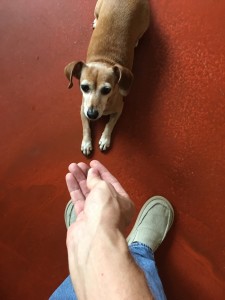Michael Baugh CDBC, CPDT-KSA
For those of us who know dogs, really know them, the love comes easily. And for those involved in the hard and difficult work of rescue and sheltering, there is no shortage of love. It’s what fuels us, what keeps us going day after day. It’s what sees us through the anguish and the tears to get out once again and rescue and shelter some more. Love is the thing. But is it enough?
Psychiatrist Aaron Beck was writing about human relationships when he jumped to the answer. His book from the late 80’s was called Love is Never Enough. His idea was for people, especially couples, to use the tools of cognitive therapy to improve their lives together. Listen. Separate out feelings (at least don’t jump to feelings first). Be mindful. Love was not enough. It never was. We had to think as well.
What would Aaron Beck say about those of us who rescue and shelter dogs? Do we love too much? Does our love ricochet us into darker emotions, sadness, anger, hate, and despair? Does it paralyze us; keep us from acting at all because the problem of abandoned and suffering dogs is just too big? That was my story up until recently. Is love not only “never enough,” but is it also sometimes what gets in the way of doing the work? I won’t speculate on what Dr. Beck would say.
Here is what we do know, the sad facts:
- Too many dogs are abandoned or born into homelessness. In Houston the numbers are huge.
- These dogs suffer from health issues ranging from mange to broken bodies to heartworms. Most rescue groups raise funds for the proper medical treatment for all of the animals in their care.
- Nearly every one of these dogs also suffers from behavior problems ranging from poor manners to extreme fear of humans to aggression toward humans or other dogs. Very few rescue groups provide professionally structured behavior care for any of their animals.
That last point interests me the most. Here’s why. 89.7% of dogs end up in shelters in the first place because of behavior problems (Wells and Hepper 2000). My colleague, Carolyn Grob, presented this bit of data and more at a recent Project Rusty Seminar in Houston (more about Project Rusty in a moment). So, we know going into this that at least 89% of dogs in rescue and shelters are there because of behavior problems. We know it like we know they have mange or a broken leg or heartworms.
Connecting the dots is pretty easy. If we help the dogs in our care learn better behavior, we increase the chance that their adoption will be successful and lasting. We justify the time and expense involved the same way we justify medical treatment. Adopters don’t want a mangy dog. Guess what? They don’t want a rude freaked out dog either.
So, let’s get back to the love. Won’t love and a little time heal most behavior issues, like fear and aggression? The short answer is no. In fact, with many dogs the problems just get worse. Can’t a dog learn to trust humans again? Yes, of course. But love and time are not enough, not really, not ever. And let’s not even talk about the jumping and leash pulling and other crazy hyper goofy behavior. Add some well-intentioned love and that unruliness can turn into downright rude-dog stuff. But, I digress.
What would Beck say? I’m not sure, but I have an idea. What if we step back from a moment and give this behavior thing some thought? We won’t stop loving. We’ll just starting thinking a bit. Let’s be mindful about training and behavior. There’s a process to treating medical issues right? There has to be a process for helping dogs act better and feel better around their new humans. (Of course there is, said the trainer).
In fact, there’s a time-honored and well-tested process for teaching animals how to act and feel better. It boils down to showing the dogs in our care that their behavior (their actions) matter. Good things happen when they behave a certain way (the way we like). Nothing much good happens when they don’t. Because we’re using rewards (reinforcement) like food and play, we’re also teaching the dogs that we humans are safe, nice in fact. We won’t get bogged down in the technical terms like Learning Theory and Classical Conditioning. We can just think of it like this. We teach the dogs what works for them in our crazy human world – and at the same time we teach them that we’re not all that crazy after all. Humans are pretty darn good it turns out.
The process is not hard. It can be fun once we get the hang of it. But, it’s not magic either. We have to show up, and we have to put in some effort. Get the dog out of the crate, into a space where we can interact with him one-on-one, and let’s start training. It’s like taking the dog to the vet for medical care, equally important, but with less hassle. Forget Aaron Beck for a moment. Here’s what trainer educator Ken Ramirez from The Shed Aquarium says: Training isn’t a luxury. It’s an essential part of daily animal care.
“Wait a minute”, you might say, “I’m not a trainer.” Well, that’s where Project Rusty comes in. That’s the group I mentioned a little bit ago. Project Rusty is a nonprofit organization in Houston with a mission to teach shelter staff and rescue volunteers how to be trainers. The truth is, you are already teaching the dogs in your care every day. Every waking minute they are learning, not just from you but also from your family, the cat, the bird, and of course from the other dogs in your home. The question isn’t whether or not they’re being trained (they are). The question is are they learning the stuff we want them to learn. Probably not.
Let’s change that. In the months and years ahead Project Rusty will be rolling out programs to help shelters and rescue groups better care for the behavioral health of their dogs. We’ve actually already started with interactive seminars. The next step will be more intensive learning programs for rescue groups, some of which are already in development. There will also be online resources for staff, volunteers and the general public. If behavior is the problem, then we will be the solution. All of us. Together.
 So where’s the love? I can only speak for myself on this one. I love my dogs. I love some of my client’s dogs too, and most came from shelters and rescue groups. I write about love and compassion and hope and all the soft stuff. I’m that guy. Is love enough? Maybe not. But, maybe that’s also not the right question. Maybe the question is how do we love these dogs? What is the thing? What is the stuff of love? For me it’s the moment I look at a dog and understand and know in my heart and in my brain that she understands too. It’s communication, clichéd as that sounds. It’s learning and teaching and blurring the lines between the two. Who’s training whom?
So where’s the love? I can only speak for myself on this one. I love my dogs. I love some of my client’s dogs too, and most came from shelters and rescue groups. I write about love and compassion and hope and all the soft stuff. I’m that guy. Is love enough? Maybe not. But, maybe that’s also not the right question. Maybe the question is how do we love these dogs? What is the thing? What is the stuff of love? For me it’s the moment I look at a dog and understand and know in my heart and in my brain that she understands too. It’s communication, clichéd as that sounds. It’s learning and teaching and blurring the lines between the two. Who’s training whom?
Love is a verb.
When I’m training with my dog I am loving my dog. It’s in my actions, and hers too I think. Teaching is loving. Learning and teaching more is loving more. And, if that’s so then loving is the thing, loving thoughtfully with our actions. It’s what we do, mindfully and wholeheartedly? Can we ever really get enough?
Michael will be leading an interactive presentation about this topic on May 4th in Houston. Visit his Houston Dog Training Events page for more information.



